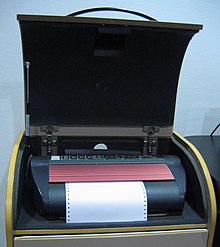Braille printer
Braille printers print or punch raised Braille characters on special paper, Braille paper. In this way, information is made legible or tangible for visually impaired people who have mastered blind dot writing. Templates that were created in black letters on a PC can be converted into Braille using a special program . Like conventional printers, the Braille printer is controlled via the PC and then prints out the document in blind dot font.
Due to the availability of other media, the demand for Braille printers and Braille writing has decreased in recent years. Alternatives to the PC-controlled printer are mechanical or electronic braille machines .
Device types for different usage situations
Braille printers are available in different price and quality classes. Small, handy Braille printers with single sheet feed are suitable for private use or if shorter documents are only rarely printed.
For more frequent use, e.g. B. at the workplace, there are Braille printers for continuous paper and double-sided printing. This not only saves time, it also saves expensive paper. When using such printers, it is advisable to buy noise insulation in the form of a soundproof hood or a soundproof cabinet.
After all, there are very fast and precise printers for the professional creation of Braille books, leaflets, etc. B. also print single sheets on both sides so that they only have to be bound. It is also possible to print graphics.
If longer texts have to be printed frequently, the provider should provide software for creating shorthand prints. In Braille, whole words or parts of words (e.g. prefixes, suffixes, word stems, etc.) are represented by one or two Braille characters. Compared to the same text in full text for the blind, the number of characters in the text for the blind is reduced by up to 40% - depending on the abbreviation option. The creation of documents in shorthand for the blind saves time and paper.
Development of a cheap alternative to expensive Braille printers
Since 2015, three students from Mainz have been working on an inexpensive alternative to the expensive braille printer. This does not punch the dots into the paper as usual, but pierces a hole in the paper with a needle . This creates a survey on the other side that the blind and visually impaired can read. The printer consists mainly of self-printed parts from a 3D printer .
Web links
Individual evidence
- ↑ The BrailleDruRo - Braille for the home. Retrieved November 15, 2017 .
